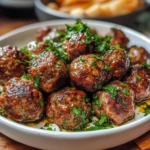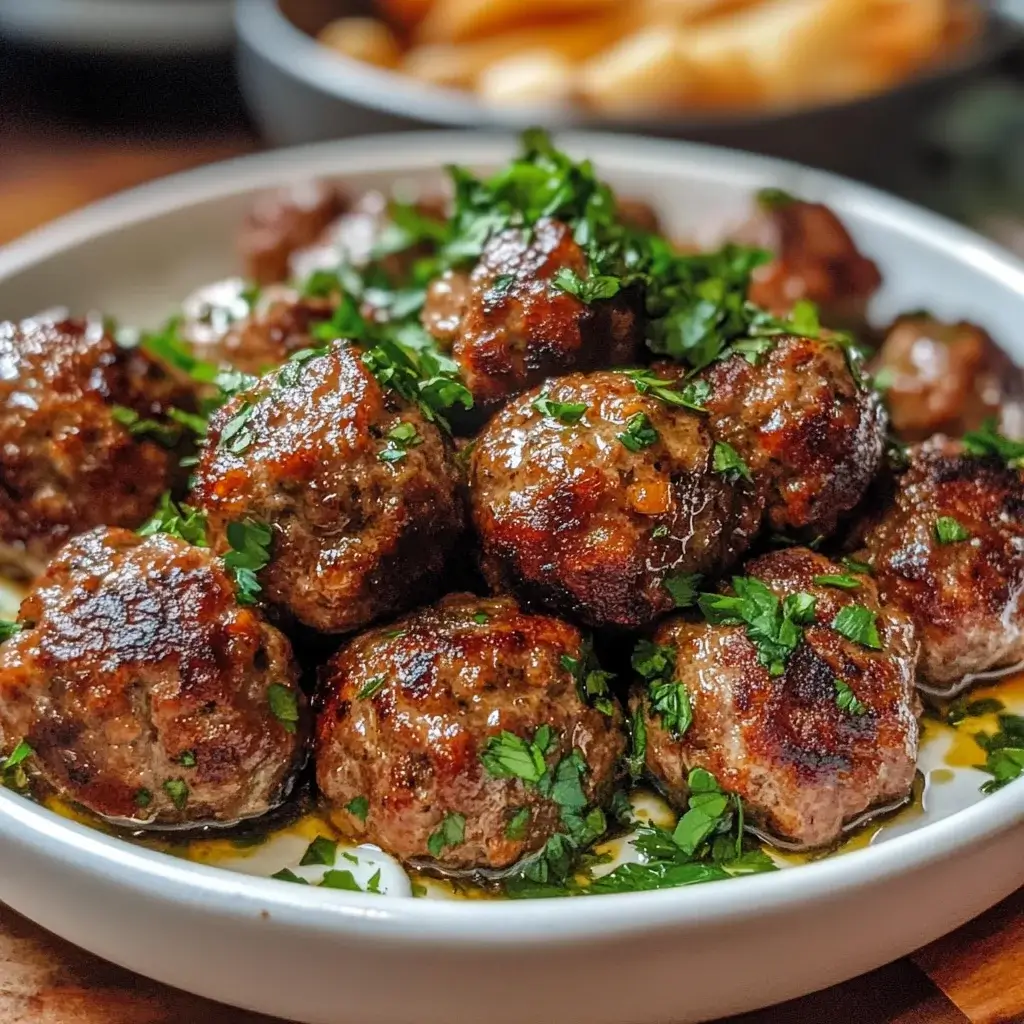Weeknights can be a whirlwind, but lately, I’ve been on a mission to bring more flavor and excitement to our family dinners without spending hours in the kitchen. That’s how I discovered the magic of Mediterranean Lamb Meatballs. From the first tantalizing aroma wafting through the house as they baked, I knew this recipe was a winner. And the taste? Absolutely incredible. These aren’t your average meatballs; they’re bursting with fresh herbs, warm spices, and a hint of lemon zest that transports you straight to the sunny shores of the Mediterranean. My kids, usually meatball skeptics, devoured them, dipping them in creamy tzatziki and piling them onto warm pita bread. Even my husband, who considers himself a meatball connoisseur, declared them the best he’d ever had. What I loved most was how surprisingly easy they were to make. A quick mix, a simple roll, and into the oven they went. These Mediterranean Lamb Meatballs have become a new family favorite, perfect for a satisfying weeknight meal or a crowd-pleasing appetizer. If you’re looking to add a touch of Mediterranean flair to your table and impress everyone with minimal effort, you absolutely must try this recipe. You won’t regret it.
Ingredients for Flavorful Mediterranean Lamb Meatballs
The secret to truly exceptional Mediterranean Lamb Meatballs lies in the quality and combination of ingredients. Each element plays a crucial role in building the complex and aromatic flavor profile that defines this dish. Let’s break down each ingredient and understand its contribution:
- Ground Lamb: The star of the show, 1.5 pounds of ground lamb provides the rich, savory base for these meatballs. Lamb has a distinct, slightly gamey flavor that pairs beautifully with Mediterranean herbs and spices. When selecting ground lamb, opt for lamb with a fat content of around 15-20%. This fat is essential for keeping the meatballs moist and flavorful during cooking. If you prefer a leaner meatball, you can use leaner ground lamb, but be mindful that they may be slightly drier. Avoid lamb that looks pale or has an off-odor, ensuring freshness for the best taste.
- Breadcrumbs: To create tender and light meatballs, we use 1/2 cup of breadcrumbs. Breadcrumbs act as a binder, helping to hold the meatballs together and absorb moisture, preventing them from becoming dense or tough. Panko breadcrumbs are an excellent choice for their light and airy texture, but regular breadcrumbs also work well. For a gluten-free option, use gluten-free breadcrumbs or almond flour. Soaking the breadcrumbs in milk or broth before adding them to the meat mixture helps to further tenderize the meatballs.
- Milk or Broth: Adding 1/4 cup of milk or broth to the breadcrumbs is a crucial step for moisture and tenderness. The liquid softens the breadcrumbs, creating a panade that helps to keep the meatballs moist during cooking. Milk adds richness, while broth (chicken or vegetable) adds a subtle savory depth. You can use whole milk, 2% milk, or even non-dairy milk options like almond milk or oat milk. For broth, low-sodium options are recommended to control the salt content.
- Onion: Finely diced 1/2 cup of onion adds a foundational savory flavor and aromatics to the meatballs. Yellow or white onions are suitable choices. Dice the onion finely to ensure it cooks through evenly and blends seamlessly into the meatball mixture. Sautéing the onion lightly before adding it to the mixture can enhance its sweetness and mellow its raw bite, but this is optional for a quicker preparation.
- Garlic: Minced 2-3 cloves of garlic are essential for that signature Mediterranean flavor. Garlic provides a pungent and aromatic base note that complements the lamb and herbs beautifully. Use fresh garlic cloves for the best flavor. Mince the garlic finely using a garlic press or by hand to ensure it distributes evenly throughout the meatballs. Roasted garlic can also be used for a sweeter, mellower garlic flavor.
- Fresh Parsley: Chopped 1/4 cup of fresh parsley adds brightness, freshness, and a vibrant green color to the meatballs. Flat-leaf parsley (Italian parsley) is preferred for its robust flavor, but curly parsley can also be used. Chop the parsley finely to release its aromatic oils and ensure it blends well into the meatball mixture.
- Fresh Mint: Chopped 1/4 cup of fresh mint is a key ingredient that defines the Mediterranean character of these meatballs. Mint adds a refreshing, slightly sweet, and cooling element that balances the richness of the lamb and spices. Spearmint or peppermint can be used, with spearmint being slightly milder. Chop the mint finely to release its fragrant oils and distribute it evenly.
- Lemon Zest: The zest of 1 lemon provides a bright, citrusy lift that enhances all the other flavors. Lemon zest adds a subtle acidity and aromatic complexity that cuts through the richness of the lamb and spices. Use a microplane or fine grater to zest the lemon, being careful to only remove the yellow outer layer and avoid the bitter white pith underneath.
- Spices: A blend of warm Mediterranean spices is crucial for depth and complexity:
- Ground Cumin: 1 teaspoon of ground cumin adds a warm, earthy, and slightly smoky note.
- Ground Coriander: 1 teaspoon of ground coriander provides a citrusy, warm, and slightly sweet flavor that complements the cumin.
- Dried Oregano: 1 teaspoon of dried oregano adds a classic Mediterranean herbaceousness and slightly peppery flavor.
- Red Pepper Flakes (Optional): 1/4 teaspoon of red pepper flakes (or to taste) adds a subtle hint of heat, balancing the richness and sweetness. Omit if you prefer a milder flavor.
- Egg: 1 large egg acts as a binder, helping to hold the meatball mixture together and add moisture. The egg protein coagulates during cooking, solidifying the meatballs and preventing them from crumbling.
- Olive Oil: 2 tablespoons of olive oil are used for cooking the meatballs, whether pan-frying or baking. Olive oil adds richness and flavor and helps to brown the meatballs beautifully. Extra virgin olive oil is preferred for its flavor and health benefits, but regular olive oil can also be used.
- Salt and Black Pepper: Essential seasonings to enhance all the flavors. Use salt and freshly ground black pepper to taste. Season the meatball mixture generously with salt and pepper to bring out the flavors of the lamb, herbs, and spices. Taste the mixture before cooking and adjust seasoning as needed.
Having these high-quality, fresh ingredients ready is the first step towards creating truly delicious and authentic Mediterranean Lamb Meatballs. Each ingredient is carefully chosen to contribute to a symphony of flavors that will tantalize your taste buds.
Instructions: Making Perfect Mediterranean Lamb Meatballs
Now that you have all your ingredients prepped and ready, let’s dive into the step-by-step instructions for creating these flavorful Mediterranean Lamb Meatballs. Follow these steps carefully for best results:
- Prepare the Breadcrumb Mixture: In a small bowl, combine the breadcrumbs and milk or broth. Let this mixture sit for 5-10 minutes to allow the breadcrumbs to absorb the liquid and soften. This step is crucial for creating moist and tender meatballs. The softened breadcrumbs, or panade, help to bind the meatball mixture and prevent it from becoming dry.
- Combine Meatball Ingredients: In a large mixing bowl, gently combine the ground lamb, softened breadcrumb mixture, diced onion, minced garlic, chopped parsley, chopped mint, lemon zest, ground cumin, ground coriander, dried oregano, red pepper flakes (if using), and egg. Season generously with salt and freshly ground black pepper. Use your hands to gently mix all the ingredients together until just combined. Be careful not to overmix the meatball mixture, as this can result in tough meatballs. Mix just until everything is evenly distributed.
- Shape the Meatballs: Using your hands or a tablespoon, form the meatball mixture into 1.5-2 inch meatballs. Aim for uniform size to ensure even cooking. You can make them slightly larger or smaller depending on your preference and intended use (appetizer vs. main course). Gently roll each meatball between your palms to create a smooth, round shape. Place the shaped meatballs on a baking sheet lined with parchment paper or lightly greased.
- Cook the Meatballs (Choose your method): You have two main cooking options: baking or pan-frying. Baking is generally healthier and easier, while pan-frying creates a crisper exterior.
- Baking: Preheat your oven to 400°F (200°C). Drizzle the meatballs lightly with olive oil. Bake for 20-25 minutes, or until the meatballs are cooked through and lightly browned. The internal temperature should reach 165°F (74°C). Baking is a hands-off method and results in tender and evenly cooked meatballs.
- Pan-Frying: Heat olive oil in a large skillet over medium-high heat. Once the oil is hot, carefully place the meatballs in the skillet, working in batches if necessary to avoid overcrowding. Sear the meatballs on all sides until browned and cooked through, about 8-10 minutes total. Lower the heat to medium if they are browning too quickly before being cooked through. Pan-frying creates a delicious crispy crust on the outside of the meatballs.
- Rest and Serve: Once the meatballs are cooked through, remove them from the oven or skillet. Let them rest for 5-10 minutes before serving. Resting allows the juices to redistribute throughout the meatballs, resulting in more tender and flavorful meatballs. While the meatballs are resting, you can prepare your serving accompaniments and garnishes. Serve the Mediterranean Lamb Meatballs hot, garnished with fresh parsley or mint, and with your favorite Mediterranean sides and sauces.
Following these detailed instructions will guide you to create perfectly cooked, flavorful, and tender Mediterranean Lamb Meatballs that will be a hit with your family and friends. Enjoy the process and the delicious results!
Nutrition Facts of Mediterranean Lamb Meatballs
Understanding the nutritional profile of your Mediterranean Lamb Meatballs can help you make informed choices about your meal. Please note that these values are estimates and can vary based on specific ingredient brands, portion sizes, and cooking methods. The nutrition facts below are based on baking the meatballs. Pan-frying may slightly increase the fat and calorie content due to the added oil.
Serving Size: 3-4 meatballs (approximately 4 ounces or 113 grams)
Approximate Nutritional Values per Serving (3-4 meatballs):
- Calories: 280-350 kcal (This can vary based on the size of the meatballs and fat content of the lamb)
- Protein: 25-30g
- Fat: 15-20g
- Saturated Fat: 6-8g
- Unsaturated Fat: 8-12g
- Cholesterol: 120-150mg
- Carbohydrates: 8-12g
- Fiber: 1-2g
- Sugars: 1-2g (Naturally occurring sugars)
- Sodium: 300-400mg (Can vary based on added salt and broth if used)
Key Nutritional Highlights:
- High in Protein: Lamb meatballs are an excellent source of high-quality protein, essential for muscle building, repair, and overall bodily functions.
- Good Source of Iron: Lamb is a good source of heme iron, which is more easily absorbed by the body than non-heme iron found in plant-based foods. Iron is crucial for red blood cell production and energy levels.
- Source of B Vitamins: Lamb provides various B vitamins, including B12, niacin, and riboflavin, which are important for energy metabolism and nervous system function.
- Contains Zinc: Lamb is a good source of zinc, an essential mineral for immune function, wound healing, and cell growth.
- Healthy Fats: While lamb contains fat, a portion of it is unsaturated fat, including monounsaturated fats, which are considered heart-healthy. Olive oil used in cooking also contributes healthy fats.
Considerations:
- Calorie and Fat Content: Lamb meatballs are moderately calorie and fat-dense due to the ground lamb and olive oil. Be mindful of portion sizes if you are watching your calorie or fat intake. Choosing leaner ground lamb can help reduce fat content.
- Saturated Fat: Lamb contains saturated fat. While some saturated fat is okay in a balanced diet, it’s important to consume it in moderation.
- Sodium Content: Sodium content can vary depending on added salt and broth. Using low-sodium broth and being mindful of added salt can help control sodium levels.
- Balanced Meal: To create a balanced meal, pair Mediterranean Lamb Meatballs with plenty of vegetables, whole grains, and healthy sauces like tzatziki or tomato sauce.
This nutritional information provides a general overview. For more precise values, you can use online nutrition calculators and input the specific brands and quantities of ingredients you use. Remember to balance your Mediterranean Lamb Meatballs with healthy side dishes to create a well-rounded and nutritious meal.
Preparation Time for Mediterranean Lamb Meatballs
Planning your cooking time is essential, especially when preparing a flavorful dish like Mediterranean Lamb Meatballs. Here’s a breakdown of the preparation time for this recipe:
- Prep Time: 20-25 minutes
- Ingredient Gathering and Washing: 5 minutes
- Vegetable Chopping (onion, garlic, herbs): 10 minutes
- Breadcrumb Soaking: 5 minutes (passive time)
- Meatball Mixture Preparation and Mixing: 10 minutes
- Meatball Shaping: 10 minutes
- Cook Time: 20-25 minutes
- Baking: 20-25 minutes
- Pan-Frying: 8-10 minutes (per batch, may take longer depending on batch size)
- Resting Time: 5-10 minutes
Total Time (Approximate):
- Baking: 45-60 minutes
- Pan-Frying: 40-50 minutes (excluding potential multiple batches for frying)
Time-Saving Tips:
- Pre-mince Garlic and Onion: If you frequently cook with garlic and onion, you can mince a larger batch in advance and store it in the refrigerator for a couple of days.
- Use Pre-chopped Herbs: While fresh herbs are best, using pre-chopped fresh herbs from the grocery store can save a few minutes.
- Prepare Meatball Mixture Ahead: The meatball mixture can be prepared up to a day in advance and stored in the refrigerator. Shape the meatballs just before cooking.
- Efficient Mise en Place: Having all your ingredients measured, chopped, and ready to go before you start mixing significantly streamlines the process and reduces prep time.
Planning for Success:
- Read the Recipe Thoroughly: Before you start, read through the entire recipe to understand all the steps and ensure you have all the necessary ingredients and equipment.
- Set a Timer: Use timers for each step, especially cooking time, to avoid overcooking or burning.
- Factor in Resting Time: Don’t forget to factor in resting time into your overall meal planning. This is crucial for tender and juicy meatballs.
By understanding the preparation time breakdown and utilizing time-saving tips, you can efficiently prepare and enjoy your delicious Mediterranean Lamb Meatballs, even on a busy weeknight. This recipe is manageable for a weeknight dinner and is also impressive enough for weekend gatherings.
How to Serve Mediterranean Lamb Meatballs
Mediterranean Lamb Meatballs are incredibly versatile and can be served in numerous delicious ways. Here are some serving suggestions to create a complete and satisfying meal or appetizer:
Main Course Options:
- With Pasta: Toss the meatballs with your favorite pasta, such as spaghetti, linguine, or penne. Pair with a simple tomato sauce, a creamy lemon sauce, or a pesto sauce for a Mediterranean twist. Sprinkle with grated Parmesan cheese and fresh basil.
- With Rice or Couscous: Serve the meatballs over fluffy rice (basmati, jasmine, or brown rice) or couscous. Drizzle with pan juices or a light lemon-herb sauce. Add a side of roasted vegetables or a fresh salad for a balanced meal.
- In Pita Bread or Wraps: Stuff warm pita bread or wraps with the meatballs, tzatziki sauce, hummus, chopped tomatoes, cucumbers, red onions, and lettuce for a delicious and customizable Mediterranean sandwich or wrap.
- With Roasted Vegetables: Serve the meatballs alongside a medley of roasted Mediterranean vegetables like bell peppers, zucchini, eggplant, red onions, and tomatoes. Drizzle everything with olive oil and sprinkle with herbs.
- Over Polenta or Mashed Potatoes: For a comforting meal, serve the meatballs over creamy polenta or mashed potatoes. Top with a flavorful tomato sauce or pan gravy.
Appetizer Options:
- On Skewers: Thread cooked meatballs onto skewers with cherry tomatoes, olives, and feta cheese cubes for a flavorful and visually appealing appetizer. Serve with tzatziki or hummus for dipping.
- With Toothpicks and Dipping Sauce: Serve the meatballs on a platter with toothpicks for easy grabbing. Offer a variety of dipping sauces such as tzatziki, hummus, baba ghanoush, marinara sauce, or a lemon-herb yogurt sauce.
- Mini Meatball Sliders: Serve smaller meatballs in mini slider buns with tzatziki sauce and sliced cucumbers for fun and flavorful appetizer sliders.
- Meatball Mezze Platter: Include the meatballs as part of a larger Mediterranean mezze platter, alongside hummus, baba ghanoush, olives, feta cheese, pita bread, and fresh vegetables.
Sauce and Condiment Pairings:
- Tzatziki Sauce: A classic Greek yogurt and cucumber sauce that is perfect for dipping or drizzling over the meatballs. Its coolness and tanginess balance the richness of the lamb.
- Hummus: Creamy hummus made from chickpeas, tahini, and lemon juice is another excellent dipping option, adding a nutty and savory element.
- Baba Ghanoush: Smoky baba ghanoush made from roasted eggplant provides a flavorful and earthy dip.
- Marinara Sauce: A simple tomato-based marinara sauce is a versatile option, especially when serving meatballs with pasta.
- Lemon-Herb Yogurt Sauce: A light and refreshing yogurt sauce flavored with lemon juice, fresh herbs (dill, mint, parsley), and garlic.
- Spicy Harissa Yogurt Sauce: For a kick, mix harissa paste into plain yogurt for a spicy and flavorful dipping sauce.
Garnish Ideas:
- Fresh Parsley or Mint: Chopped fresh parsley or mint sprinkled over the meatballs adds freshness and visual appeal.
- Lemon Wedges: Serve with lemon wedges for squeezing fresh lemon juice over the meatballs to brighten the flavors.
- Toasted Pine Nuts or Sesame Seeds: Sprinkle toasted pine nuts or sesame seeds for added texture and nutty flavor.
- Crumbled Feta Cheese: Crumbled feta cheese adds a salty and tangy finish.
- Olive Oil Drizzle: A drizzle of high-quality extra virgin olive oil enhances the flavor and adds richness.
By exploring these serving suggestions and sauce pairings, you can create a variety of delicious meals and appetizers featuring your flavorful Mediterranean Lamb Meatballs. Get creative and enjoy experimenting with different combinations to find your favorites!
Additional Tips for Perfect Mediterranean Lamb Meatballs
To ensure your Mediterranean Lamb Meatballs are consistently delicious and perfectly cooked, here are five additional tips to keep in mind:
- Don’t Overmix the Meatball Mixture: Overmixing the meatball mixture is a common mistake that leads to tough, dense meatballs. Mix the ingredients gently with your hands just until everything is combined. Avoid kneading or pressing the mixture excessively. Overworking the meat develops gluten and makes the meatballs chewy and less tender. Treat the mixture delicately for the best texture.
- Test a Meatball Before Cooking All: To ensure the seasoning is just right, cook a small тестовый meatball before shaping and cooking the entire batch. Form a small meatball and pan-fry or bake it until cooked through. Taste it and adjust the seasoning of the remaining meatball mixture as needed. This allows you to fine-tune the salt, pepper, and spice levels to your preference before committing to cooking the whole batch.
- Moisten Your Hands When Shaping: To prevent the meatball mixture from sticking to your hands when shaping, lightly moisten your hands with water or olive oil. This makes the shaping process much easier and cleaner. It also helps to create smoother, more uniform meatballs. Re-moisten your hands as needed during the shaping process.
- Chill Meatballs Before Cooking (Optional but Recommended): Chilling the shaped meatballs in the refrigerator for 20-30 minutes before cooking helps them hold their shape better during cooking and prevents them from spreading or flattening. Chilling firms up the fat in the lamb, which helps the meatballs maintain their round shape and stay moist during baking or pan-frying. This step is especially helpful if you are pan-frying the meatballs.
- Don’t Overcrowd the Pan or Baking Sheet: Whether you are pan-frying or baking, avoid overcrowding the pan or baking sheet with meatballs. Overcrowding lowers the temperature and can cause the meatballs to steam instead of brown, resulting in uneven cooking and less flavorful meatballs. Cook the meatballs in batches if necessary to ensure they have enough space to brown properly and cook through evenly. For baking, leave some space between each meatball on the baking sheet. For pan-frying, work in batches to maintain high heat and achieve a good sear.
By following these additional tips, along with the recipe instructions, you’ll be well on your way to creating Mediterranean Lamb Meatballs that are not only delicious but also perfectly textured and consistently amazing. These small details can make a big difference in the final result.
Frequently Asked Questions (FAQ) about Mediterranean Lamb Meatballs
Here are some frequently asked questions about making Mediterranean Lamb Meatballs, to help you troubleshoot and ensure success:
Q1: Can I use ground beef instead of ground lamb?
A: Yes, you can substitute ground beef for ground lamb if you prefer or if lamb is not readily available. Ground beef will result in a different flavor profile, as it lacks the distinct gamey taste of lamb. However, the Mediterranean herbs and spices will still create a flavorful meatball. For best results with ground beef, use ground beef with a fat content of around 15-20% to keep the meatballs moist. You can also use a mixture of ground beef and ground lamb for a balanced flavor.
Q2: Can I make these meatballs gluten-free?
A: Yes, you can easily make these meatballs gluten-free by substituting the breadcrumbs with gluten-free breadcrumbs or almond flour. Ensure that any broth or milk you use is also gluten-free if necessary. All the other ingredients in the recipe are naturally gluten-free. Gluten-free breadcrumbs or almond flour will work similarly to regular breadcrumbs as a binder and moisture absorber.
Q3: Can I freeze Mediterranean Lamb Meatballs?
A: Yes, Mediterranean Lamb Meatballs freeze very well, making them perfect for make-ahead meals. Cook the meatballs according to the recipe instructions. Allow them to cool completely. Then, arrange them in a single layer on a baking sheet lined with parchment paper and freeze until solid. Once frozen, transfer the meatballs to a freezer-safe bag or container. They can be stored in the freezer for up to 2-3 months. To reheat, you can bake them directly from frozen at 350°F (175°C) until heated through, or thaw them in the refrigerator overnight and then reheat them in a skillet, oven, or microwave.
Q4: What dipping sauces go well with these meatballs besides tzatziki?
A: While tzatziki is a classic and excellent pairing, many other dipping sauces complement Mediterranean Lamb Meatballs. Hummus, baba ghanoush, marinara sauce, a lemon-herb yogurt sauce, or a spicy harissa yogurt sauce are all delicious options. You can also experiment with other Mediterranean dips or create your own dipping sauce based on your preferences. The versatility of these meatballs allows them to pair well with a wide range of flavors.
Q5: Can I make these meatballs ahead of time and cook them later?
A: Yes, you can prepare the meatball mixture ahead of time, shape the meatballs, and store them in the refrigerator for up to 24 hours before cooking. Store the shaped meatballs covered in an airtight container in the refrigerator. Cook them as directed in the recipe when you are ready to serve. This is a great time-saving tip for busy weeknights or when preparing for a gathering.
These FAQs address common questions and concerns that might arise when making Mediterranean Lamb Meatballs, ensuring you have the knowledge to tackle any challenges and create a successful and delicious dish. If you have further questions, don’t hesitate to consult other online resources or cooking communities for additional tips and support.
Print
Mediterranean Lamb Meatballs recipe
Ingredients
-
- Ground Lamb: The star of the show, 1.5 pounds of ground lamb provides the rich, savory base for these meatballs. Lamb has a distinct, slightly gamey flavor that pairs beautifully with Mediterranean herbs and spices. When selecting ground lamb, opt for lamb with a fat content of around 15-20%. This fat is essential for keeping the meatballs moist and flavorful during cooking. If you prefer a leaner meatball, you can use leaner ground lamb, but be mindful that they may be slightly drier. Avoid lamb that looks pale or has an off-odor, ensuring freshness for the best taste.
-
- Breadcrumbs: To create tender and light meatballs, we use 1/2 cup of breadcrumbs. Breadcrumbs act as a binder, helping to hold the meatballs together and absorb moisture, preventing them from becoming dense or tough. Panko breadcrumbs are an excellent choice for their light and airy texture, but regular breadcrumbs also work well. For a gluten-free option, use gluten-free breadcrumbs or almond flour. Soaking the breadcrumbs in milk or broth before adding them to the meat mixture helps to further tenderize the meatballs.
-
- Milk or Broth: Adding 1/4 cup of milk or broth to the breadcrumbs is a crucial step for moisture and tenderness. The liquid softens the breadcrumbs, creating a panade that helps to keep the meatballs moist during cooking. Milk adds richness, while broth (chicken or vegetable) adds a subtle savory depth. You can use whole milk, 2% milk, or even non-dairy milk options like almond milk or oat milk. For broth, low-sodium options are recommended to control the salt content.
-
- Onion: Finely diced 1/2 cup of onion adds a foundational savory flavor and aromatics to the meatballs. Yellow or white onions are suitable choices. Dice the onion finely to ensure it cooks through evenly and blends seamlessly into the meatball mixture. Sautéing the onion lightly before adding it to the mixture can enhance its sweetness and mellow its raw bite, but this is optional for a quicker preparation.
-
- Garlic: Minced 2-3 cloves of garlic are essential for that signature Mediterranean flavor. Garlic provides a pungent and aromatic base note that complements the lamb and herbs beautifully. Use fresh garlic cloves for the best flavor. Mince the garlic finely using a garlic press or by hand to ensure it distributes evenly throughout the meatballs. Roasted garlic can also be used for a sweeter, mellower garlic flavor.
-
- Fresh Parsley: Chopped 1/4 cup of fresh parsley adds brightness, freshness, and a vibrant green color to the meatballs. Flat-leaf parsley (Italian parsley) is preferred for its robust flavor, but curly parsley can also be used. Chop the parsley finely to release its aromatic oils and ensure it blends well into the meatball mixture.
-
- Fresh Mint: Chopped 1/4 cup of fresh mint is a key ingredient that defines the Mediterranean character of these meatballs. Mint adds a refreshing, slightly sweet, and cooling element that balances the richness of the lamb and spices. Spearmint or peppermint can be used, with spearmint being slightly milder. Chop the mint finely to release its fragrant oils and distribute it evenly.
-
- Lemon Zest: The zest of 1 lemon provides a bright, citrusy lift that enhances all the other flavors. Lemon zest adds a subtle acidity and aromatic complexity that cuts through the richness of the lamb and spices. Use a microplane or fine grater to zest the lemon, being careful to only remove the yellow outer layer and avoid the bitter white pith underneath.
-
- Spices: A blend of warm Mediterranean spices is crucial for depth and complexity:
-
- Ground Cumin: 1 teaspoon of ground cumin adds a warm, earthy, and slightly smoky note.
-
- Ground Coriander: 1 teaspoon of ground coriander provides a citrusy, warm, and slightly sweet flavor that complements the cumin.
-
- Dried Oregano: 1 teaspoon of dried oregano adds a classic Mediterranean herbaceousness and slightly peppery flavor.
-
- Red Pepper Flakes (Optional): 1/4 teaspoon of red pepper flakes (or to taste) adds a subtle hint of heat, balancing the richness and sweetness. Omit if you prefer a milder flavor.
-
- Spices: A blend of warm Mediterranean spices is crucial for depth and complexity:
-
- Egg: 1 large egg acts as a binder, helping to hold the meatball mixture together and add moisture. The egg protein coagulates during cooking, solidifying the meatballs and preventing them from crumbling.
-
- Olive Oil: 2 tablespoons of olive oil are used for cooking the meatballs, whether pan-frying or baking. Olive oil adds richness and flavor and helps to brown the meatballs beautifully. Extra virgin olive oil is preferred for its flavor and health benefits, but regular olive oil can also be used.
-
- Salt and Black Pepper: Essential seasonings to enhance all the flavors. Use salt and freshly ground black pepper to taste. Season the meatball mixture generously with salt and pepper to bring out the flavors of the lamb, herbs, and spices. Taste the mixture before cooking and adjust seasoning as needed.
Instructions
-
- Prepare the Breadcrumb Mixture: In a small bowl, combine the breadcrumbs and milk or broth. Let this mixture sit for 5-10 minutes to allow the breadcrumbs to absorb the liquid and soften. This step is crucial for creating moist and tender meatballs. The softened breadcrumbs, or panade, help to bind the meatball mixture and prevent it from becoming dry.
-
- Combine Meatball Ingredients: In a large mixing bowl, gently combine the ground lamb, softened breadcrumb mixture, diced onion, minced garlic, chopped parsley, chopped mint, lemon zest, ground cumin, ground coriander, dried oregano, red pepper flakes (if using), and egg. Season generously with salt and freshly ground black pepper. Use your hands to gently mix all the ingredients together until just combined. Be careful not to overmix the meatball mixture, as this can result in tough meatballs. Mix just until everything is evenly distributed.
-
- Shape the Meatballs: Using your hands or a tablespoon, form the meatball mixture into 1.5-2 inch meatballs. Aim for uniform size to ensure even cooking. You can make them slightly larger or smaller depending on your preference and intended use (appetizer vs. main course). Gently roll each meatball between your palms to create a smooth, round shape. Place the shaped meatballs on a baking sheet lined with parchment paper or lightly greased.
-
- Cook the Meatballs (Choose your method): You have two main cooking options: baking or pan-frying. Baking is generally healthier and easier, while pan-frying creates a crisper exterior.
-
- Baking: Preheat your oven to 400°F (200°C). Drizzle the meatballs lightly with olive oil. Bake for 20-25 minutes, or until the meatballs are cooked through and lightly browned. The internal temperature should reach 165°F (74°C). Baking is a hands-off method and results in tender and evenly cooked meatballs.
-
- Pan-Frying: Heat olive oil in a large skillet over medium-high heat. Once the oil is hot, carefully place the meatballs in the skillet, working in batches if necessary to avoid overcrowding. Sear the meatballs on all sides until browned and cooked through, about 8-10 minutes total. Lower the heat to medium if they are browning too quickly before being cooked through. Pan-frying creates a delicious crispy crust on the outside of the meatballs.
-
- Cook the Meatballs (Choose your method): You have two main cooking options: baking or pan-frying. Baking is generally healthier and easier, while pan-frying creates a crisper exterior.
-
- Rest and Serve: Once the meatballs are cooked through, remove them from the oven or skillet. Let them rest for 5-10 minutes before serving. Resting allows the juices to redistribute throughout the meatballs, resulting in more tender and flavorful meatballs. While the meatballs are resting, you can prepare your serving accompaniments and garnishes. Serve the Mediterranean Lamb Meatballs hot, garnished with fresh parsley or mint, and with your favorite Mediterranean sides and sauces.
Nutrition
- Serving Size: one normal portion
- Calories: 280-350
- Sugar: 1-2g
- Sodium: 300-400mg
- Fat: 15-20g
- Saturated Fat: 6-8g
- Unsaturated Fat: 8-12g
- Carbohydrates: 8-12g
- Fiber: 1-2g
- Protein: 25-30g
- Cholesterol: 120-150mg






